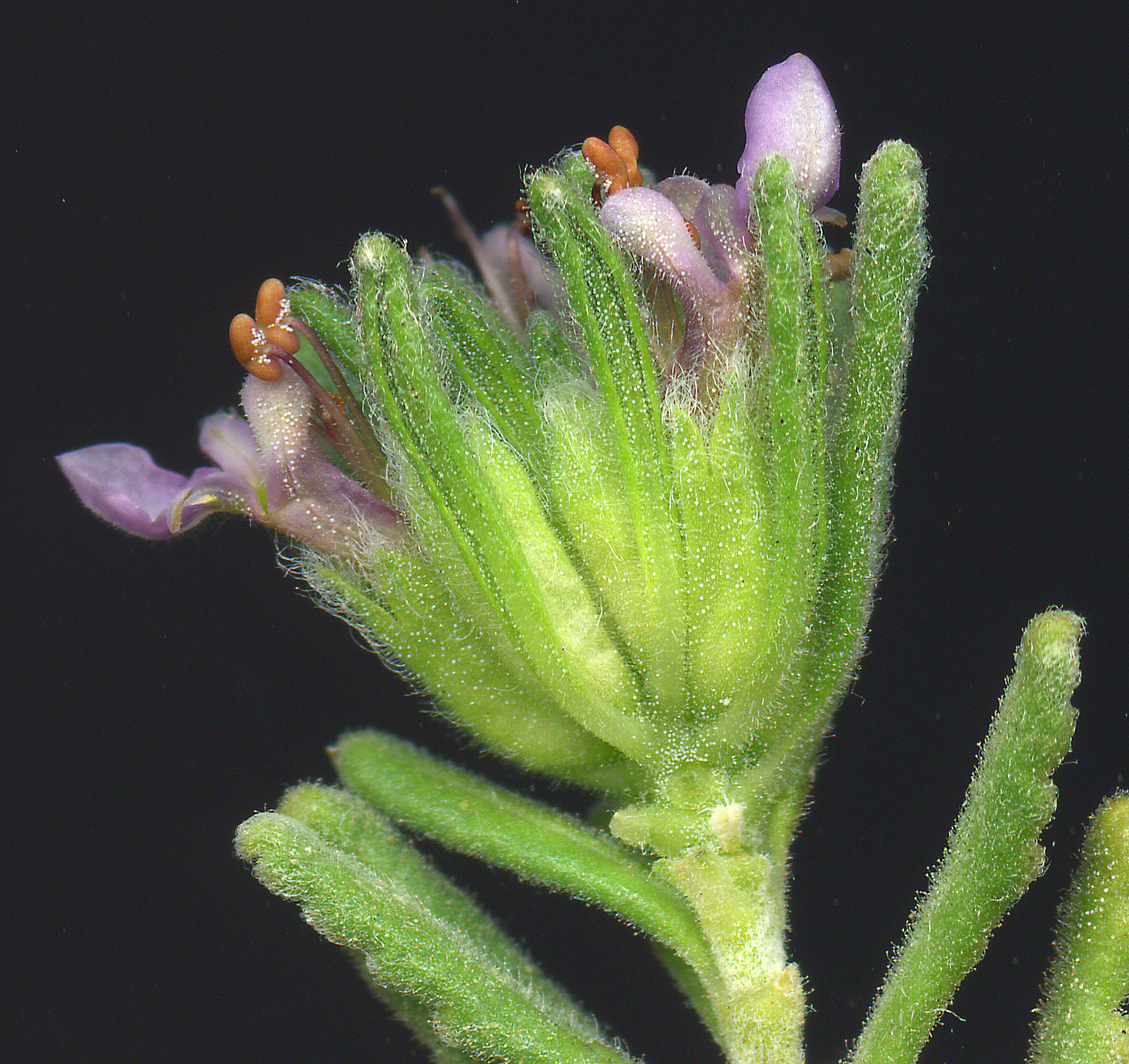Teucrium salaminium

Distribution
Description
Shrub, 15-40 cm high, with erect or suberect stems. Indumentum consists out of the following types of trichomes: (1) short and long clavate glandular trichomes, mostly with 2-3 stalk cells, (2) subsessile one-celled glandular trichomes, (3) non-glandular, unbranched, thick-walled trichomes, with 2 to several stalk cells. Old wood greyish-brown, fissured; current year's shoots straight, terete, erect to suberect, simple or variously branched, lengthening up to 20(-30) cm; lowermost part of the shoots remaining alive throughout the year becomes leafless; the upper part bearing the flower heads dries out; indumentum consists of dense, white, crisped or adpressed eglandular, unbranched hairs, intermixed with spreading, long or short glandular ones. Leaves subsessile or shortly petiolate, narrowly to broadly oblanceolate or elliptical, 12-22 × 3-6 mm when fully open, olive-green to green on both sides, becoming yellowish-green with age; margins slightly revolute, the lower ½-¾ entire or somewhat sinuate-undulate, the upper ¼-½ with an apical tooth and (0-)2-4(-7) crenations on either side; leaves appearing from late spring onwards become progressively smaller, narrowly oblong to linear, tufted on top of the sterile shoots, 4-11(-19) × 1.5-2(-2.5) mm when fully opened, subsessile or sessile, olive-green to green on both sides; margins strongly revolute, entire except for an apical tooth, or the upper ¼-½ with 2-4 crenations on each side and an apical tooth; both surfaces of the leaves with sessile glands, at first with lax to dense, white, unbranched, spreading or subappressed, short or long glandular and eglandular hairs, becoming appressed and crisped with age. Flower heads obpyramidal or obconical, flattopped or slightly rounded, by the end of the flowering period many slightly elongated and ovoid, (6-)8-16 × (6-)8-16 mm, arising on top of long shoots or on lateral, long or short branches, altogether giving the appearance of a lax panicle; sometimes the heads on top of the long shoots are subtended by 2-4 smaller, subsessile ones. Bracts foliaceous, greenish, for most of the flowering period, equal or exceeding the flowers, all more or less reaching to the same height, 4.5-7.5(-2.4) × 0.5- 1.3 mm, linear, narrowly oblong or oblanceolate, with revolute margins, entire, except for an apical tooth. Bracteoles absent. Flowers 4-15(-20) per head, sessile or shortly petiolate, sometimes 1-2 of the central buds never open. Calyx tubular, 4-6.1 mm; tube curved, 3.2-4.3 × 1.8-2 mm, 5-nerved, reticulately veined, externally with sessile glands and lax or dense white, spreading or adpressed, crisped, short or long glandular and eglandular hairs and internally with spreading or shortly subadpressed, eglandular and glandular hairs; teeth somewhat unequal; the abaxial deltoid, somewhat acuminate, 1-1.8 × 0.5- 0.7 mm, the adaxial about 0.8-1.3 × 0.8-1 mm. Corolla tube 2.5-5 × 0.8-1.3 mm, slightly curved, glabrous to subglabrous towards the base externally, glabrous towards the base internally, pubescent at the region of the throat; limb white flashed with pink-violet on the lower part or pinkish-violet all over, 4- 6 mm long; basal lobes oblong, 1.2-2 × 0.5-0.8 mm, lateral lobes spreading, oblong, 1.1-1.3(-1.4) × 0.3-0.6 mm, median lobe nearly circular, 1.6-2.5 × 1.2-2.1 mm, cucullate; external surface thinly pubescent and with sessile glands; internal surface gland-dotted, hirsute at the region of the basal and lateral lobes, glabrous at the lateral lobes. Stamens inserted at or slightly below the mouth of corolla tube, exserted; filaments pinkish-violet above, thinly pilose, the adaxial 1.3-3.7 mm long, the abaxial 2.5-5.3 mm long; anthers pinkish-violet, 0.5-1 mm long. Ovary glabrous, about 0.5-0.8 mm long; style thinly pubescent, 4.5-6 mm long; stigmatic lobes subulate, unequal, 0.5-0.9 mm long. Nutlets somewhat cochleariform to obovate, 1.1-1.3 × 0.7-0.9 mm, rounded at apex, wedge-shaped at the base, attachment area flat, suborbicular, 0.6-0.7 mm in diameter, adjacent area convex; dark brown to blackish, granulose, slightly reticulately veined and foveolate.
Source: Hadjikyriakou G. & Hand R. 2011: Teucrium salaminium (Lamiaceae, Teucrium sect. Polium), a new species from Cyprus. - Candollea 66: 341-351.
Source: Hadjikyriakou G. & Hand R. 2011: Teucrium salaminium (Lamiaceae, Teucrium sect. Polium), a new species from Cyprus. - Candollea 66: 341-351.
